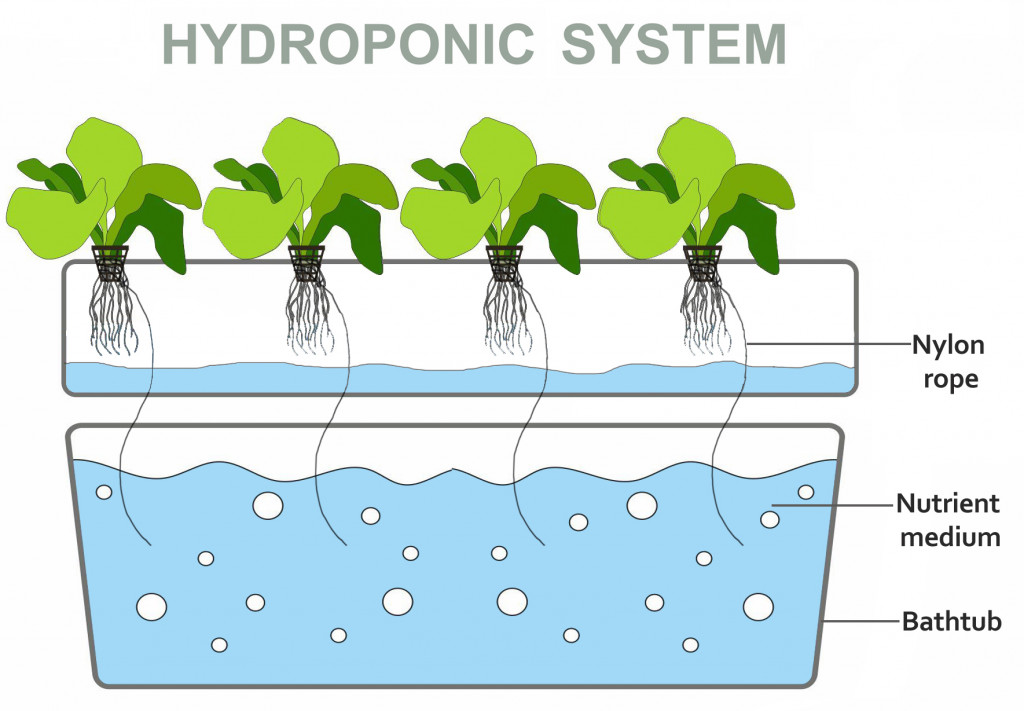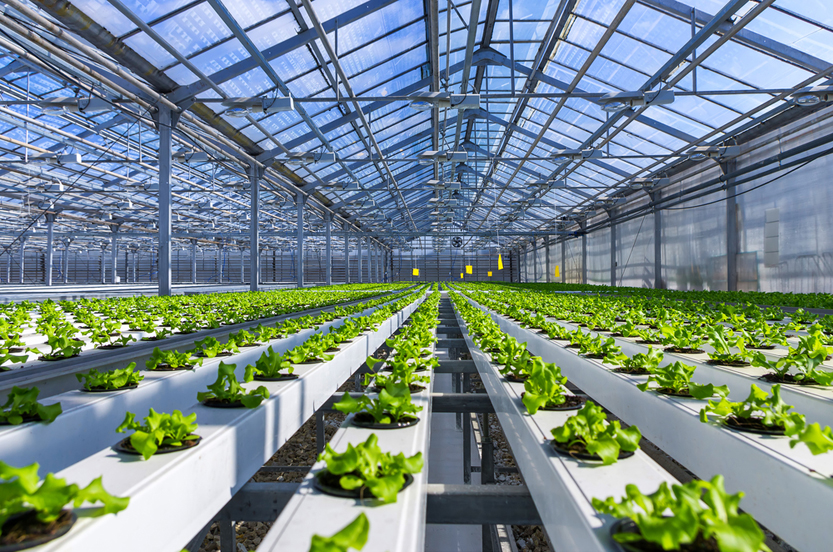Believe it or not, it is possible to grow plants without any soil being involved. The practice of growing plants in water mixed with certain minerals and nutrients is called hydroponics. This new technique is being posited as an alternative to traditional soil-based farming and gardening.
There are two kinds of “bathroom people”… bathroom singers and bathroom thinkers! If you are of the second kind, you have likely thought about some rather ridiculous things while lying in your bathtub.
However, has it ever crossed your mind to grow a farm in there? Obviously, you don’t want your bathtub filled with soil and your drains choked with mud, but what if you didn’t need any soil? What if you could grow your farm using only water?
This seemingly strange notion is actually an exciting and rapidly developing field of science called hydroponics.
What Is Hydroponics?
Hydroponics is the science of growing plants without soil. The term originates from two Greek roots ‘hydros,’ meaning water, and ‘ponos,’ meaning work.
Just like humans, plants need nutrients to grow. These nutrients are absorbed from the soil and circulated to the different parts of the plant. If you have always believed that plants require soil, just know that you’re not the first to make that mistake!
For centuries, scientists believed that soil was an essential element of plant growth. However, soil can be just as easily replaced by a nutrient medium. A nutrient medium is a liquid that contains all the nutrients necessary for growth. Plants grown in this way are called water cultures.

Also Read: Do Plants Hold The Soil Or Is It The Other Way Round?
Bathroom Farming: How Can You Implement Hydroponics In Your Home?
Step One: Creating A Nutrient Medium
First, we would need to create a nutrient medium that can replace the soil.
A nutrient medium is basically water with nutrients and minerals that are important for the plants to grow. The most basic nutrient medium must contain nitrogen, phosphorus, potassium, calcium, magnesium and sulphur.
Most nutrient media, in correct proportions, are readily available on the market.
There are also many great books that give a detailed explanation of chemicals and their necessary amounts for making the nutrient medium. However, if you’re someone who prefers going “natural”, here are some natural components you can use.
Substances like gypsum, lime, bone meal or eggshells are rich in calcium, banana peels are high in potassium, baker’s yeast adds phosphorus, while beans and lentil water can be used for nitrogen. Be careful, however, as these are not perfectly measured and tested approaches, so you might need several tries before you get it right.
Step 2: Making The Physical Set Up
The general idea of water cultures is to suspend the plant on some form of support and dangle its roots into the nutrient medium below. In this way, the plant has a never-ending supply of nutrients. Therefore, if you want to be a bathtub farmer, you will need a bit more than a bathtub.
You could secure a piece of mesh above the bathtub edge, elevate your plants over it, and then fill the tub with the nutrient medium.
You could also take a pipe, cut small circles through it and place your plants in the holes. You could then suspend their roots in a bathtub below. If your plants are too small, you could lightly tie the roots with a nylon rope and let the nutritious water gently work its way up!
All you need to do is make sure that the nutrient medium is balanced correctly, the roots are always dipped into the liquid, and the plant is receiving adequate sunlight at all times.

Also Read: How Can We Replenish Soil Nitrogen Without Using Synthetic Fertilizers?
Advantages Of Hydroponics: How Is It Better Than Traditional Farming?
For starters, it’s a lot less messy.
If you hate digging your fingers in the mud or having creepy crawlies frolic on you, then hydroponics is the choice for you.
Since plants in a hydroponic system have ample access to water and nutrients, they don’t spend excess energy developing elaborate root systems. As a result, you get fresher and healthier plants, as well as a greater yield in half the time.
When scientists compared hydroponics and conventional farming, they found that hydroponically-grown plants showed about a 17% increase in the yield. In another study, a hydroponically grown potato plant yielded 75 potatoes, whereas one grown in soil yields only 3 to 5. Potatoes grown using hydroponics were also found to be 51% larger than those grown in pots!
One can also use hydroponics in places where traditional farming isn’t possible.
Furthermore, it increases the green areas in your living space. It requires only about 10% of the water and 25% of the fertilizers/nutrients that soil-based agriculture demands, meaning that it is relatively easy on overhead costs. You can grow garden-fresh yields with very little experience or setup.
A paper in the International Journal of Agricultural Extension compared the strawberry yield obtained from hydroponic vs. soil systems. They claimed, “Growing strawberries in hydroponic systems is feasible, at a reasonable cost and more sustainable compared to traditionally soil-grown systems.
Future research should investigate various hydroponic growing methods and the feasibility of growing at the commercial level.”
Commercial Hydroponics
Scientists have been using water cultures in some form since the early 1930s. However, these cultures were carefully monitored in the laboratory under set conditions. Moreover, they were only implemented to study plant structure and nutrition. The use of this technique for commercial production was far less common.
We also didn’t have standardized nutrient media that could be ordered off the internet.
But don’t worry! If you decide to be a bathtub farmer, you can still have a promising future. Currently, hydroponic markets are growing at an incredible rate. According to an article in Businesswire, the Global Hydroponics market is expected to grow from $226.45 million in 2016 to an estimated $724.87 million by 2023.

Disadvantages of Hydroponics: Why Hasn’t It Caught Up With Traditional Farming?
A primary reason is that the initial cost of installment for commercial use can be high. Apart from such economic constraints, scientists are facing three other issues that hinder large-scale production.
All present techniques use complicated apparatus and costly refining materials. Scientists haven’t been able to develop a simple procedure that could be used even by the most unskilled laborer with limited assistance.
Next, all techniques currently in place were originally used to study plant physiology and nutrition. They do not address issues faced in a large-scale farming setting. Also, scientists don’t fully understand the water dynamics of hydroponic systems. We can’t properly explain why or how plants growing hydroponically have a different root architecture.
A Final Word
In theory, all plants can be grown hydroponically, but we don’t know how plants from different species and climatic conditions react to hydroponic systems. We also don’t know the significance for differences in the types of roots. Above all, we haven’t figured out how a major change to a growing style will affect the evolutionary future of the species.

Even NASA is experimenting with hydroponics, as plants grown in space can provide astronauts with a fresh diet and provide oxygen. This ‘bio-regenerative life support system’ is being experimented with in order to provide a food source for the Moon and Mars colonization missions.
With all this in mind, the next time you find a seed that has just begun to sprout, try throwing it in your bathtub instead. You never know what the future could hold as an aspiring hydroponics farmer… you might even help humanity get a foothold on Mars!
Also Read: How Do Astronauts Grow Plants In Space?
How well do you understand the article above!

References (click to expand)
- Asao T. (2012). Hydroponics: A Standard Methodology for Plant Biological Researches. BoD – Books on Demand
- Gericke, W. F. (1945, February 9). The Meaning of Hydroponics. Science. American Association for the Advancement of Science (AAAS).
- (2016) Treftz | International Journal of Agricultural Extension. journals.esciencepress.net
- Hydroponics Online - Hydroponics tutorials, forums, designs .... hydroponicsonline.com
- How Hydroponics Works - Home and Garden - HowStuffWorks. HowStuffWorks
- DIY Hydroponic Nutrients: 6 Cheap Homemade Recipes. thehydroponicsplanet.com
